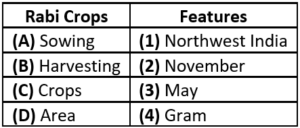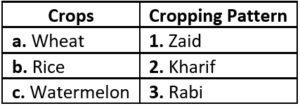What is Case Study Question / Paragraph Based Question?
A case study is a scenario in a particular academic / professional context which students are expected to analyse and respond to, guided by specific questions posed concerning the situation. In many cases, the scenario or case study involves a number of issues or problems that must be dealt with in a academic / professional workplace.
Why Case Study Questions are included in academics?
Case study assignments usually require students to identify problems and issues in a scenario, to demonstrate their developing knowledge of theories and academic / professional policies and to make decisions and recommendations based on these to either prevent or solve some of the issues in that scenario.
How to solve Case Study Questions?
There are several steps to writing an answer to a case study assignment:
STEP 1: Read the case study and questions carefully.
- Read the case and associated questions carefully.
- Highlight the main points of the case and any issues that you can identify.
- Read the questions closely and analyse what they are requiring you to do.
- Read the case again, linking the information that is relevant to each question you have been asked.
STEP 2: Identify the issues in the case study.
Case studies describe a situation which may arise in a particular profession or social context. They often involve a number of people in a complex situation. They will often describe a situation which is problematic, possibly in how it is dealt with, or in its complexity. An important part of your answer is to analyse the situation and to identify the issues/actions described in the case which may be problematic. The following questions may help you to do this:
- What actions were taken in the case?
- Were these actions the most appropriate and why?
- Were there any consequences of the actions taken?
- Was anything omitted or not considered?
- Were actions/procedures in line with existing codes of practice, policy or theories?
STEP 3: Link theory to practice.
Use your knowledge of existing codes of practice, theories and/or other academic / professional documents and behaviours to decide what was done appropriately and what was not.
STEP 4: Plan your answer.
It can be useful to use the questions you have been set as headings and to answer each part in turn, reducing the chance of omitting set questions. You can always take out the headings before you submit if you wish. Lecturers usually set questions in a logical order, so answer in the order they are written in your question.
STEP 5: Start writing your case study answer (for theory only)
Like any assignment, you will need an introduction, body sections in which you answer the questions put to you regarding the case study, and a conclusion.
STEP 6: Edit and proofread.
Read through your paper yourself to detect and correct other errors and omissions.
Check you have answered all questions and backed up your answer with relevant passage.
Types of Case Study Questions / Paragraph Based Questions
Case Study Questions / Paragraph Based Questions can be broadly classified into two types:
- MCQs type: In this type, student has to tick the correct option from various options.
- Theory type: In this type, student has to write proper solution / answer in cotext to the case study.
Case Study/ Passage Based Questions Chapter 4 Agriculture
Type 1: MCQ type
Case Study Question 01
Read the extract given below and answer the questions that follow:
Primitive Subsistence Farming : This type of farming is still practised in a few pockets of India. Primitive subsistence agriculture is practised on small patches of land with the help of primitive tools like a hoe and digging sticks, and family/community labour. This type of farming depends upon monsoon, natural fertility of the soil and suitability of other environmental conditions to the crops grown.
Intensive Subsistence Farming: This type of farming is practised in areas of high population pressure on land. It is labour intensive farming, where high doses of biochemical inputs and irrigation are used for obtaining higher production. Though the ‘right of inheritance’ leading to the division of land among successive generations has rendered land-holding size uneconomical, the farmers continue to take the maximum output from the limited landin the absence of an alternative source of livelihood. Thus, there is enormous pressure on agricultural land.
Commercial Farming: The main characteristic of this type of farming is the use of higher doses of modern inputs, e.g. high yielding variety (HYV) seeds, chemical fertilisers, insecticides and pesticides in order to obtain higher productivity. The degree of commercialisation of agriculture varies from one region to another. For example, rice is a commercial crop in Haryana and Punjab, but in Odisha, it is a subsistence crop.
Plantation: Plantation is also a type of commercial farming. In this type of farming, a single crop is grown on a large area. The plantation has an interface of agriculture and industry. Plantations cover large tracts of land, using capital intensive inputs, with the help of migrant labourers. All the produce is used as a raw material in the respective industries. Tea in Assam and North Bengal coffee in Karnataka are some of the important plantation crops grown in these states.
Answer the following MCQs by choosing the most appropriate option:
Question.1. Tea in Assam: Plantation Crop, Rice in Odisha: __________.
(a) Primitive Subsistence crop
(b) Commercial crop
(c) Plantation crop
(d) Subsistence crop
Question.2. Which of the following is not correct about plantation farming?
(a) In this type of farming, a single crop is grown on a large area.
(b) The plantation has an interface of agriculture and industry.
(c) Plantations cover large tracts of land called estates.
(d) Farmers clear a patch of land by felling trees and burning them, to produce cereals and other food crops.
Question.3. ________ is done in a mechanised way using capital intensive inputs and particularly timely irrigation making maximum use of large tracts of land.
(a) Intensive Subsistence Farming
(b) Plantation Farming
(c) Commercial Farming
(d) Jhum Farming
Question.4. Complete the given table:
(a) Farmers use chemical fertilisers, insecticides and pesticides.
(b) Farmers use high doses of biochemical inputs.
(c) Farmers use simple and basic tools and irrigation methods.
(d) Farmers use mechanised tools and machines.
Ans.1. (d) Subsistence crop
Ans.2. (d) Farmers clear a patch of land by felling trees and burning them, to produce cereals and other food crops.
Ans.3. (b) Plantation Farming
Ans.4. (c) Farmers use simple and basic tools and irrigation methods.
Case Study Question 02
Read the extract given below and answer the questions that follow:
Rabi crops are sown in winter from October to December and harvested in summer from April to June. Some of the important rabi crops are wheat, barley, peas, gram and mustard. Though, these crops are grown in large parts of India, states from the north and north-western parts such as Punjab, Haryana, Himachal Pradesh, Jammu and Kashmir, Uttarakhand and Uttar Pradesh are important for the production of wheat and other rabi crops. Availability of precipitation during winter months due to the western temperate cyclones helps in the success of these crops. However, the success of the green revolution in Punjab, Haryana, western Uttar Pradesh and parts of Rajasthan has also been an important factor in the growth of the above mentioned rabi crops.
Answer the following MCQs by choosing the most appropriate option :
Question.1. Rabi crops are sown in _______ and harvested in ________.
Question.2. Match the following in relation to Rabi Crops:
(a) A-(1), B-(2), C-(3), D-(4)
(b) A-(4), B-(3), C-(1), D-(2)
(c) A-(2), B-(3), C-(4), D-(1)
(d) A-(3), B-(4), C-(1), D-(2)
Question.3. Which type of impact does summer rainfall put on Rabi crops?
(a) Positive
(b) Negative
(c) No Effect
(d) None of these
Question.4. Which of the following factor has given boost to Rabi crops in Northwest India?
(a) Demand by Population
(b) Awareness of Farmers
(c) Rainfall
(d) Green Revolution
Ans.1. Winter, Summer
Ans.2. (c) A-(2), B-(3), C-(4), D-(1)
Ans.3. (c) No Effect
Ans.4. (d) Green Revolution
Case Study Question 03
Read the extract given below and answer the questions that follow:
We understand the physical diversities and plurality of cultures in India. These are also reflected in agricultural practices and cropping patterns in the country. Various types of food and fibre crops, vegetables and fruits, spices and condiments, etc. constitute some of the important crops grown in the country. India has three cropping seasons — rabi, kharif and zaid.
A variety of food and non-food crops are grown in different parts of the country depending upon the variations in soil, climate and cultivation practices. Major crops grown in India are rice, wheat, millets, pulses, tea, coffee, sugarcane, oilseeds, cotton and jute, etc.
Answer the following MCQs by choosing the most appropriate option:
Question.1. Millets come in the category of ________ crops.
(a) food
(b) non-food
(c) bevarage
(d) None of these
Question.2. Identify which cropping pattern the following crops belong to:
Choose the correct option:
(a) a-2, b-1, c-3
(b) a-3, b-2, c-1
(c) a-1, b-3, c-2
(d) a-3, b-1, c-2
Question.3. Which one of the following is not a physical feature that influence cropping pattern?
(a) Soil
(b) Terrain
(c) Dense population
(d) Air moisture
Question.4. In order to increase the crop output, a farmer can control _________.
(a) Cultivation practices
(b) Sunlight
(c) Humidity
(d) Physiography
Ans.1. (a) food
Ans.2. (b) a-3, b-2, c-1
Ans.3. (c) Dense population
Ans.4. (a) Cultivation practices.
Type 2: Theory Type
Case Study Question 04
Read the extract and answer the questions that follows:
Intensive Subsistence Farming is practised in areas of high population pressure on land. It is labour intensive farming, wherehigh doses of biochemical inputs and irrigation are used for obtaining higher production. Though the ‘right of inheritance’ leading to the division of land among successive generations has rendered land holding size uneconomical, the farmers continue to take maximum output from the limited land in the absence of alternative source of livelihood. Thus, there is enormous pressure on agricultural land. The main characteristics of commercial farming is the use of higher doses of modern inputs, e.g. high yielding variety (HYV) seeds, chemical fertilisers, insecticides and pesticides in order to obtain higher productivity. The degree of
commercialisation of agriculture varies from one region to another. For example, rice is a commercial crop in Haryana and Punjab, but in Odisha, it is a subsistence crop.
Question.1. What leads to the division of land among successive generations has rendered land holding size uneconomical?
Question.2. How does commercial farming maximise it productivity?
Ans.1. The ‘Right of inheritance ‘leads to the division of land among successive generations has rendered land-holding size uneconomical.
Ans.2.
(i) The main characteristics of commercial farming is the use of higher doses of modern inputs.
(ii) Some of the examples are high yielding variety (HYV) seeds, chemical fertilisers, insecticides and pesticides in order to obtain higher productivity.






